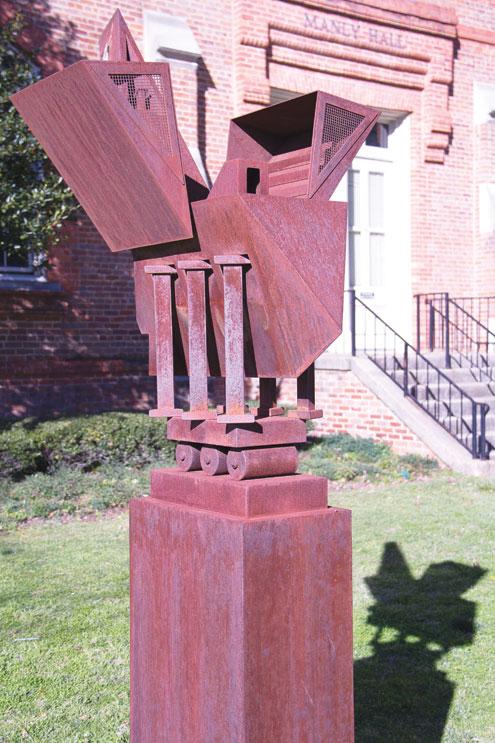The discolored thrust of steel in front of Manly Hall has a name, a creator and a purpose, none of which are declared by a plaque or logo to identify the artwork.
In fact, the steel sculpture is not designed to withstand the caprice of outside weather, but walk past Manly Hall adjacent to Clark Hall, and there it is, rusting under the open sky.
Andrew Arvanetes drew from melancholy episodes in his personal life to name the creation of his steel sculpture “Phoenix.”
According to an emailed statement from Rebecca Florence, director of college relations and associate director of development for the College of Arts and Sciences, the University brought “Phoenix” to campus in 1993, when the steel sculpture won the Purchase Award in the 1993 Alabama Biennial. The Biennial was an exhibition for outdoor artwork of “heroic proportions” that incorporated other sculptures like “Phoenix” into the campus aesthetic. The Biennial, funded by anonymous donations, ran in 1991, 1993 and 1995 until the donations dried up, much like the current crusty exterior of Arvanetes’ steel sculpture.
“That’s a little disappointing,” he said when informed his artwork had taken a permanent vacation in the sun. “It had a very clean, slick finish to it. It’s a shame.”
Arvanetes had lost some members of his family to a drunk driver before the hosting of the 1993 Biennial. When he was told the theme of the artwork for the exhibition had to draw from mythology, the tale of the phoenix instantly snapped into his head.
“The piece is called ‘Phoenix’ for the mythological bird that rises from the ashes to live again,” he said. “At the time, it was right after some pretty substantial loss in my family, and the parameters of the exhibition had to do something with mythology. I thought about the idea of death and rebirth. That’s why I did the piece in the first place.”
Arvanetes makes use of vehicular and mechanical details to distinguish his artwork. Interested in sculpture since his youth, he decided to pursue the hands-on mode of expression in his days in college.
“My sister told me once, ‘You know, you’re building the same thing you were as a kid, but it’s out of steel and not blocks,’” he said. “It was something always in me.”
“A lot of artists have just done it and been amazing their whole lives,” he added. “I did not think of it as a vocation until I got older, but as a kid, I was always fascinated with all these things that people make.”
Arvanetes likes to infuse movement, transition and biographical narrative into his artwork without imposing a finicky interpretation onto his audience.
“I use details that people may not know what they really mean but can make a story of their own kind, which is fine,” he said.
“Sometimes, it’s what the piece appears to be doing, whether it’s moving or sailing or flying,” he continued. “It’s usually some kind of personal emotion associated with that action. I do know that with this piece, on the tail in the back, there’s an altar with bleachers in the wings, almost like there could be a funerary situation or courtroom situation where a judge might sit.”
Like a coat of polyurethane to preserve the surface of a painting, Arvanetes carefully cleaned and sprayed the steel finish of “Phoenix” with Penetrol Oil to curtail the metal from oxidizing into a heap of rust. The Penetrol Oil seals the oxidation of the surface inside at the time of its application so that the steel, in effect, quits oxidizing, he said.
He said “Phoenix,” now plopped onto a nondescript concrete block on the lawn of Manly Hall, used to be inside the lobby of a campus administration building.
“I was a little shocked, and I was hoping it was inside, but it’s not,” he said. “As long as it stays outside, it breaks down very quickly.”









